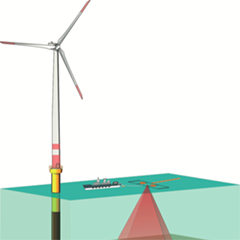Challenges in offshore wind farm installation
In recent years, the construction of offshore wind farms has flourished as many countries strive to increase the share of renewable energy in their overall energy mix. Offshore wind offers some significant advantages compared to onshore developments, including stronger and more stable wind conditions ensuring a more dependable energy output, sufficient space in the national EEZs for large projects, and, last but not least, increased public acceptance compared with onshore developments.
These benefits have fueled the realization of numerous projects not only in the North Sea, but also in many other shallow-water, mid-latitude areas of the world. However, the nature of offshore wind turbine generator (WTG) foundations and offshore environmental conditions pose serious challenges for the construction of wind farms.
Today, WTG foundations are most often constructed as monopiles: large-diameter: 5 -10 m steel pipes that are rammed, or vibrated into the seafloor sediments to a depth of 30-80 m. However, several other foundation types have been used, e.g., jacket and gravity foundations and, more recently, suction buckets in conjunction with monopoles or jackets.
The decisions as regards foundation types and necessary installation depths generally depend on the local geotechnical characteristics of the encountered sediments. Foundations are designed in the appropriate dimensions for suitable installation locations depending on the findings of extensive geophysical and geotechnical pre-site surveys, which establish the geological character of the area.
Typical areas for offshore wind development, e.g., Northern Europe, were predominantly shaped by extensive glaciations in their recent geological history. The identification of widespread boulder-prone sediments in the shallow sub-seafloor is a common challenge for pre-site surveys in these areas.
Challenges in offshore wind farm installation
In recent years, the construction of offshore wind farms has flourished as many countries strive to increase the share of renewable energy in their overall energy mix. Offshore wind offers some significant advantages compared to onshore developments, including stronger and more stable wind conditions ensuring a more dependable energy output, sufficient space in the national EEZs for large projects, and, last but not least, increased public acceptance compared with onshore developments.
These benefits have fueled the realization of numerous projects not only in the North Sea, but also in many other shallow-water, mid-latitude areas of the world. However, the nature of offshore wind turbine generator (WTG) foundations and offshore environmental conditions pose serious challenges for the construction of wind farms.
Today, WTG foundations are most often constructed as monopiles: large-diameter: 5 -10 m steel pipes that are rammed, or vibrated into the seafloor sediments to a depth of 30-80 m. However, several other foundation types have been used, e.g., jacket and gravity foundations and, more recently, suction buckets in conjunction with monopoles or jackets.
The decisions as regards foundation types and necessary installation depths generally depend on the local geotechnical characteristics of the encountered sediments. Foundations are designed in the appropriate dimensions for suitable installation locations depending on the findings of extensive geophysical and geotechnical pre-site surveys, which establish the geological character of the area.
Typical areas for offshore wind development, e.g., Northern Europe, were predominantly shaped by extensive glaciations in their recent geological history. The identification of widespread boulder-prone sediments in the shallow sub-seafloor is a common challenge for pre-site surveys in these areas.
To read the full content,
please download the PDF below.


























